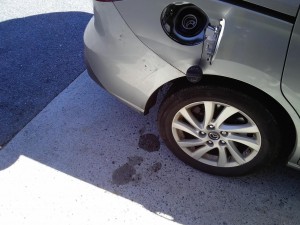17 December 2015
Tiny fuel spills at gas stations can contaminate soil
Posted by lhwang

Gas station fuel spills as small as a droplet can infiltrate concrete, potentially contaminating soil and groundwater below.
Credit: Markus Hilpert.
by Emily Benson
The oil or gas leaks that grab headlines tend to be big events such as the Deepwater Horizon spill in 2010, but smaller-scale spills can be a problem, too, new research finds. Even a few drops dribbled from the nozzle of a gas station fuel pump can penetrate concrete and contaminate soil and groundwater below, according to researchers at Johns Hopkins University in Baltimore, Maryland.
In the past, regulators and researchers assumed that most spilled fuel would evaporate into the atmosphere, said Markus Hilpert, a hydrologist at Johns Hopkins University. The possibility that small fuel droplets might seep through the concrete pad under a gas station to the soil and water below was largely ignored, he said.
A drop or two of spilled gas may not seem like a big deal, but they add up, Hilpert said.
According to a study by the California Air Resources Board, a typical gas station patron might spill 0.01 percent of the fuel he or she buys, Hilpert said. A mid-sized gas station sells about 100,000 gallons of fuel in a month, he added, which works out to 10 gallons of fuel dripping onto the ground every month – per gas station.
“If it’s just you, that’s fine – the problem is that there are many customers,” Hilpert said.
To quantify the cumulative impact of all those small spills, Hilpert and a colleague at Johns Hopkins University dripped gasoline and diesel fuel onto chunks of concrete in a lab. They monitored the mass of the fuel over time to see how much infiltrated the concrete and how much evaporated into the atmosphere.
About 10 percent of each drop of gasoline remained in the concrete after 4 hours, the researchers reported at the 2015 American Geophysical Union Fall Meeting in San Francisco. For diesel, however, a much larger proportion of each drop lingered in the concrete: about 70 to 90 percent.
When gasoline spills, the proportion that doesn’t evaporate into the atmosphere will eventually seep down through the gas station’s concrete pad as vapor, Hilpert said. He estimates that the process takes about one year in the United States, where most gas station pads are about 6 to 8 inches (15 to 20 centimeters) thick. Once the fuel vapors percolate through the concrete, they will contaminate the soil below and possibly groundwater as well, Hilpert said.
Gas stations are busy places, and small fuel spills happen over at over at the same spots, compounding the contamination problem, Hilpert said. When that happens, there is more or less a constant source of gasoline seeping into the ground, he added.
Gasoline and diesel fuel contain hazardous substances such as benzene that can be harmful even in small amounts, and “it only takes very little gasoline to contaminate water,” Hilpert said, so controlling small spills is important for preventing contamination.
– Emily Benson is a science communication graduate student at UC Santa Cruz. You can follow her on twitter at @erbenson1, or via her website.


 GeoSpace is a blog on Earth and space science, managed by AGU’s Public Information staff. The blog features posts by AGU writers and guest contributors on all sorts of relevant science topics, but with a focus on new research and geo and space sciences-related stories that are currently in the news.
GeoSpace is a blog on Earth and space science, managed by AGU’s Public Information staff. The blog features posts by AGU writers and guest contributors on all sorts of relevant science topics, but with a focus on new research and geo and space sciences-related stories that are currently in the news.
With that cases, what are the mitigating measure to prevent/control the contamination into the soil?